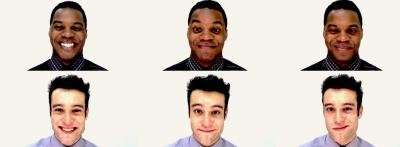Certain smiles aren't all they're cracked up to be

Sweaty palms, a racing heart, a faltering voice. Many people find public speaking unpleasant. The mere anticipation of social evaluation increases the activity of almost all body systems related to stress, with particularly strong activation in the hypothalamic-pituitary-adrenal (HPA) axis, the human body's central stress response system.
How does the HPA axis respond to feedback we receive from others in these social situations? Positive or negative verbal feedback in response to a speech, such as "that was/wasn't good", is known to activate the HPA axis. But until now little scientific inquiry has been conducted into how our bodies respond to purely nonverbal feedback, such as facial expressions.
A new study of nonverbal feedback, published today in Scientific Reports by researchers from the University of Wisconsin-Madison and Bar-Ilan University, finds that smiles may reduce or increase physical stress depending upon how they are perceived. Jared D. Martin, Heather Abercrombie and Paula Niedenthal, of the University of Wisconsin-Madison, and Eva Gilboa-Schechtman, of Bar-Ilan University, demonstrate that smiles with different social functions have different effects on HPA axis activity when they are perceived as evaluative feedback in stressful social situations.
The researchers measured cortisol levels in the saliva of 90 male undergraduate students as an indicator of HPA axis activity. They discovered that 'dominance' smiles, which challenge social standing and signal disapproval, were associated with higher HPA axis activity, such as increases in heart rate and salivary cortisol. Individuals perceiving 'dominance' smiles also took longer to return to their baseline cortisol levels after the stressful event. These physical responses to 'dominance' smiles mirror the influences of negative verbal feedback.
By contrast, 'reward' and 'affiliation' smiles, which reinforce behavior, signal lack of threat and facilitate or maintain social bonds, respectively, exerted influences similar to the effects of displays of friendliness and positive social evaluation and buffered physiological activity.
The authors also found that individuals with higher heart-rate variability - the variation in the time between each heart beat - showed more nuanced responses to different smiles. Higher heart-rate variability - an index of parasympathetic nervous system activity - is positively associated with facial expression recognition accuracy.
"The findings provide further evidence for the view that smiles do not necessarily constitute positive nonverbal feedback, and that they may impact social interactions by affecting the physiological reaction of people who perceive them. In addition, cortisol appears to support the detection of social threat and coordinate biological activity needed to adequately respond to the threat," wrote the researchers. They also noted that the findings contribute to growing evidence of individual differences in sensitivity to the meaning of facial expression.
The authors caution that the small sample of exclusively male participants limits the generalizability of the findings. Further research is needed to explore if men and women respond differently to the same kind of smile, and to test the physiological effects of more overtly negative facial expressions.
More information: Jared D. Martin et al, Functionally distinct smiles elicit different physiological responses in an evaluative context, Scientific Reports (2018). DOI: 10.1038/s41598-018-21536-1



















